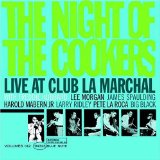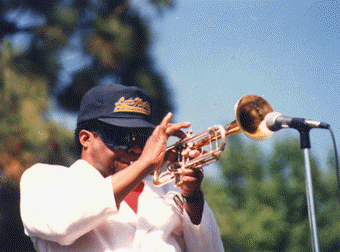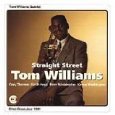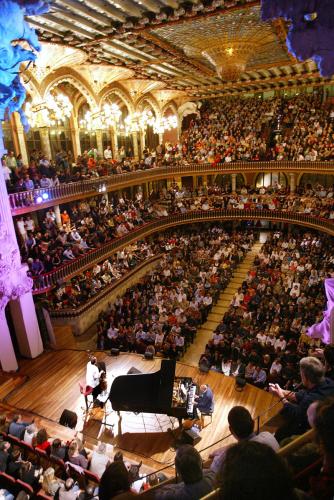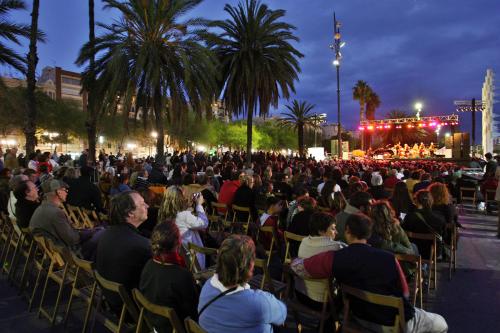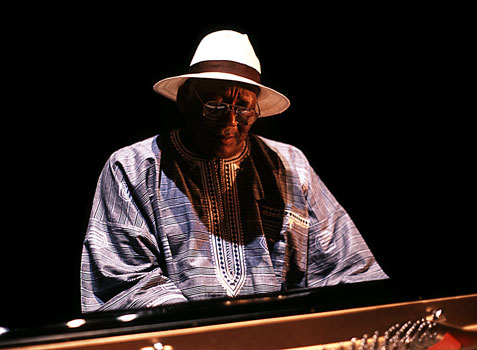Writer Eugene Holley — Wilmington’s own — is one who’s always first-rate commentary I take personal pride in. I’ve watched his development closely, ever since we worked together in developing the National Jazz Service Organization during the first stages of my directorship. Eugene’s latest liner notes enhance NEA Jazz Master Ahmad Jamal’s superb latest record "A Quiet Time" (Dreyfus). Eugene has always been someone with a great thirst for the music in its recorded medium, including vintage vinyl, so it was a natural for him to contribute to our ongoing Crate Digging series.

Eugene (far left) & friends
Back in the mid-1980s when CDs began their market dominance, some hasty music lovers liquidated their vinyl collections. Considering that you may have been a consumer/beneficiary of some of that tasty vinyl, was that an impetuous, foolish move on the part of those sellers?
Well, you’re talking to someone whose maternal grandmother lived to be 102, and talked about how she went from cylinder recordings and 78s to Lps and 45s. So for me, it was just business as usual for those sellers to adapt to the new technology. For a long time, I didn’t get rid of my LPs, mainly because I was still attached to them from a romantic and physical standpoint, because of the artwork and the liner notes. Now, as time went on and many of the LPs I had were being converted to CD, often with extra tracks, my nostalgia for LPs wore off and I slowly got rid of the LPs that were being reissued as CDs. Also, there was another factor: CDs are superior to LPs when you’re on the air! I was working at the now-defunct WDCU-FM in DC and I can’t tell you how much easlier it was to carry those smaller CDs around (laughs). [And the jazz radio guys say: Amen to that!]
What is it about vinyl recordings that continue to hold fascination for you?
No question, the warmth of analog sound! Miles Davis Kind of Blue sounds better on LP, especially Miles’ Harmon mute, which sounds less metallic on the old format. Now, I should be honest and admit that probably because I was born in the sixties, my ears are biased to the LP sound. When I encounter younger people, they don’t hear what I hear. Also, again as I said before, you can see the album art better, as well as the liner notes. Plus, the LPs made for great wall posters!
Now that MP3 is a reality — not to mention whatever Dizzy Gillespie’s formats the technocrats may cook up in the future — has vinyl receded even further in the rearview mirror, ala the 78 rpm format?
That depends on what one does with the music. If you like listening to music in your home, and you don’t mind turning the record every twenty or twenty-five minutes, or if you’re a hip-hop DJ, then LPs are your thing. Now, if you listen to music on the move, in your car, or if you’re programming a playlist for a radio show or your iPod, well the LP is definitely obsolete, and the MP3/digital formats are supreme. It’s not even close! So in that sense yes, Lps belong in the past.
As a collector, what kinds of rare vinyl recordings attract your attention?
What I look for now are LPs that I know will probably not be available in the digital format any time soon. And I also look for LPs that have artwork that can’t be reproduced digitally. For example: Dizzy Gillespie’s 1962 release The New Continent on Limelight Records, has an incredible gatefold configuration patterned after ancient Mayan hieroglyphs.

Dizzy’s The New Continent (Limelight)
Another favorite LP with a similar gatefold design is Ahmad Jamal’s Portfolio of Ahmad Jamal — released on the Chess/Cadet [Argo imprint] label in 1958. I also love looking for old Latin jazz/Cuban LPs from artists like Machito, Tito Puente, Cachao, Noro Morales — people like that. I would find those LPs in a lot of book stores in New York.
Bluebook and other ratings systems which rate the "book" value of supposed rarities aside, what in your gaze truly constitutes a "rare" vinyl record find from your collector’s perspective?
The first thing you have to consider is whether the LP is available in the digital format. Then you have to see where that LP fits in the historical continuum: was it ever commercially issued? Is it a bootleg? Unless someonee unleashes a private recording of an artist at a live date, unissued studio recordings are becoming rarer these days.
Besides the rare items, when you hit the stacks do you generally have a "wish list" in mind or are you so intrepid that you simply delight in the process purely in hopes of uncovering some useful nugget?
I’ve been crate digging for three decades, so at this point no, I don’t have a wish list per se. But yes, when I was record searching in the eighties and the nineties in DC, Atlanta, and New York, I must say that I indeed did do the detective work involved with finding that rare and out-of-print recording. Now, for better or worse, because of the internet, it’s much easier to find things. So, as B.B. King says "the thrill is gone" (laughs).
Talk about some of your recent vinyl "finds" and what it is about those records that attracted your interest sufficiently enough to cop a purchase.
The last LP I found, after searching for a long time, was the Fathers and Sons LP from Columbia, released in 1982, that featured Ellis, Wynton and Branford Marsalis, and Von and Chico Freeman (there’s a BAD version of "Nostalgic Impressions"). I found that record at Second Story Books in DC.
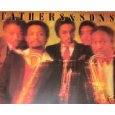
What have been your favorite sources or retail outlets for vinyl crate digging — whether that be stores, private collections, garage sales, record conventions, or some other source?
When I was in DC. Orpheus Records (Georgetown) was the place to go, and Joe’s Record Paradise in Silver Spring. When I worked at WCLK in Atlanta, Wuxtry’s was the spot, and when I lived in New York The Jazz Record Center in Manhattan was definitely the place to go — hands down! [check for our recent Crate Digging feature with Fred Cohen on The Jazz Record Center]. I also should mention the Princeton Record Exchange in New Jersey. Now, most of the outlets also have websites and you can order online, which saves you travel time. Also, there’s Ebay and Alibris.com, an excellent website for out-of-print books and CDs.
Any further thoughts or insights on the subject of Crate Digging?
The good news is that because of communications in the twenty-first century, one can virtually find any recording they want. It may not be as glamorous today hunting for that special LP as it was back in the day, but that’s the price of progress.


